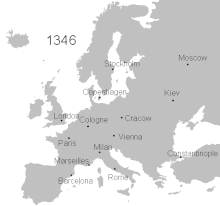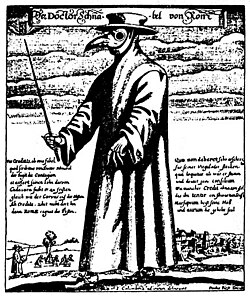Black Death


TheBlack Deathwas apandemicinEuropeandAsiaduring the14th century.
This outbreak ofdiseasewas at its worst between 1347 and 1351.
It killed between 25 million and 50 million people across Europe.[1]
Historianscannot be sure which disease caused the Black Death. However, most think that it was thebubonic plague.That is abacterialinfectioncaused by theYersinia pestisspeciesof bacteria.[2]
The Black Death may have begun inCentral AsiaorEast Asia.It definitely appeared inCrimeain 1347.[3]It was probably carried byfleasliving on blackrats,which traveled onGenoanships and brought the plague toportcities around theMediterranean.Rats may also have traveled along trade routes like theSilk Roadand brought infected fleas to European cities. When the fleas bit humans, they infected them with the plague by injecting a bit ofY. pestisbacteria into the wound.Symptomswould start three to seven days later.
Not everybody agrees that plague caused the Black Death. Some historians have suggested thatanthraxor aviral hemorrhagic fevercaused the pandemic.
Impact[change|change source]
The disease killed around a third ofEurope's population, but some areas were less affected than others. There were 75 to 200 million people acrossEurasiathat died during the pandemic.[1]
Until the 1700s, the plague seems to have reappeared in Europe at least once everygeneration.Some of the smaller plagues were more intense than others and caused more deaths. Later outbreaks include theItalian Plague of 1629–1631,theGreat Plague of London(1665–1666), theGreat Plague of Vienna(1679), theGreat Plague of Marseillein 1720–1722, and the1771 plague in Moscow.The mostvirulentform of the plague seems to have disappeared from Europe in the 18th century.
The Black Death had a very big effect on Europe'spopulation.It changed Europe'ssocial structure,which was a serious blow to theRoman Catholic Churchand resulted in widespreadpersecutionofminoritiessuch asJews,Muslims,foreigners,beggars,andlepers.The uncertainty of daily survival influenced people to live for the moment, as illustrated byGiovanni BoccaccioinThe Decameron(1353).
At the time, 14th-century European writers called the pandemic the "Great Mortality". Later outbreaks made it become called the "Black Death".
Media[change|change source]

The Black Death appears in some modern literature and media, used as a subject or asetting.For example,Edgar Allan Poe's short storyThe Masque of the Red Death(1842) is set in an unnamed country during afictionalplague that shares many things in common with the Black Death.
Albert Camus's writings used that theme too. HisnovelThe Plague(1947) was set against an outbreak of the plague inAlgeriaand discussed how people handle theepidemic.
Medical aspects[change|change source]
In humans, the bubonic plague causesfevers,severeflusymptoms, and buboes. The last are largeswellingsfilled withpusthat usually appear in thegroin,under thearms,on thethighs,and behind theears.Buboes are black and purple, which may be how the Black Death got its name. The disease waspainful,and many victims died horrible deaths.
The medical knowledge of the time was based onHippocrates's theory ofhumorism,which said the body consists of differentfluids.If they are inharmony,a person is healthy. If they are not, disease results. Very often, diseases were also seen as a punishment fromGod.
The theory of humorism did not explain why disease spreads from one person to another. Most people thought thatinfectionwas caused bymiasma( "bad air" ).The bad air could come from within the earth and so cause the disease. Remedies against the disease included opening onlynorth-facing windows, not sleeping during the day, and not working too hard.
In 1348,Philip VI of Franceasked the Faculty of Medicine of theUniversity of Parisabout the cause of the Black Death. It concluded that the pandemic had been caused by a badconjunctionofJupiter,SaturnandMarson 20 March 1345. Since that answer was based onastrology,many people believed it, and it was translated into many languages.
Because nobody understood what caused the plague,doctorshad no effective treatments. Often, doctors simply told theirpatientsto go toConfessionso that theirsins would be forgivenif they died. Eventually, the pandemic caused doctors to change their ideas about how the human body worked. Just 200 years later,Girolamo Fracastorodiscovered that diseases spread throughinfection.
Twelve plague outbreaks inAustraliabetween 1900 and 1925 caused over 1,000 deaths, mainly inSydney.That led to a Public Health Department, which did some leading-edge research. It found that plague transmission from rat fleas to humans by the bacillusYersinia pestis.[4]
Germ warfare[change|change source]
Mongol forcesused the plague as abiological weaponin 1347. That was one of the earliest uses ofgerm warfarein history.[5]
InCrimea,Mongol forces were fighting for control of Caffa, aBlack Seaport (now Feodosiya,Ukraine). At the time, Caffa was aGenoesetradecentre. Mongol forces began asiege.During the siege, they are reported to havecatapultedplague-infested bodies over the walls into the city.[5]Genoans fled the siege by using ships. Some historians believe the Caffarefugeesbrought the plague back to Italy with them, which started the pandemic.[5]
Related pages[change|change source]
References[change|change source]
- ↑1.01.1Benedictow, Ole (2021).The complete history of the Black Death.Suffolk, UK: The Boydell Press. p. 876.ISBN978-1-78744-931-2.
- ↑"Plague".World Health Organization.October 2017.Archivedfrom the original on 24 April 2015.Retrieved8 November2017.
- ↑3.03.1Sources for origins
- Hollingsworth, Julia."Black Death in China: A history of plagues, from ancient times to now".CNN.Archivedfrom the original on 6 March 2020.Retrieved24 March2020.
- Benedictow 2004,pp. 50–51
- Bramanti et al. 2016,pp. 1–26
- Wade, Nicholas (2010-10-31)."Europe's Plagues Came From China, Study Finds".The New York Times.ISSN0362-4331.Archivedfrom the original on 4 November 2010.Retrieved2020-03-01.
- "Black Death | Causes, Facts, and Consequences".Encyclopædia Britannica.Archivedfrom the original on 9 July 2019.Retrieved2020-03-01.
- Sussman 2011
- ↑Bubonic Plague comes to Sydney in 1900Archived10 February 2012 at theWayback Machine,University of Sydney, Sydney Medical School
- ↑5.05.15.2"Biological Weapons in History".britannica.Britannica.RetrievedJanuary 7,2022.
Other websites[change|change source]
Primary sources online[change|change source]
- Agnolo di Tura's account
- Gabriele de' Mussi's accountArchived2006-10-29 at theWayback Machine
- Marchionne di Coppo di Stefano Buonaiuti's accountArchived2007-02-03 at theWayback Machine
- A Petrarch accountArchived2007-02-04 at theWayback MachineandMore quotes from PetrarchArchived2007-02-04 at theWayback Machine
Secondary sources online[change|change source]
- The History Guide"Satan Triumphant: The Black Death"
- Symptoms, causes, pictures of bubonic plague
- Overview of the black death
- BBC news story on controversy over Black Death origins
- Examination of "Ring around the Rosy" 's relationship to the plague
- Black Death Overview from BBC history
- Plague and Public Health in Renaissance EuropeArchived2005-06-08 at theWayback Machine.Primary source documents and analyisis
- Secrets of the Dead. Mystery of the Black DeathArchived2014-03-25 at theWayback MachinePBS
- Pandemics in Eastern EuropeArchived2011-06-05 at theWayback Machine
